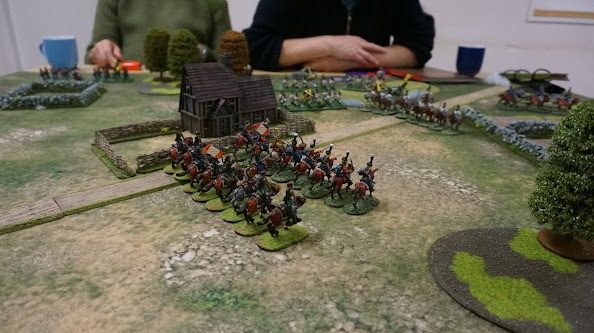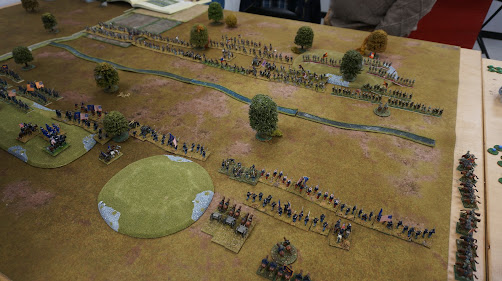When I first moved to Brussels in 2000 suddenly I found that I had a little extra money that I could spend on my hobby. At that time Wargames Foundry were releasing figures faster than I could say Wow!
I had acquired a few of the Pirate Range, largely still languishing in the Locker. I painted a crew for Legends of the High Seas but the rules did not really take off, and there is an African Expedition exploring my garage somewhere. They may even run into the Forest tribe painted all those years ago.
Yes, I know I sold a Greek army and replaced it with Steve Saleh sculpts, and added a few Macedonians to boot, but they are for another post, no, what concentrated my mind that following spring and summer was that I wanted to create a force for small actions, and not using the English Napoleonic army.
I think my inspiration came from Blasthoff bridge, but I wanted it a bit more formal. So I bought 4 units of Infantry ,and three Cavalry units a side, adding foot and horse artillery, and command. Mostly through Foundry deals, so some things are a bit odd. Oh, and there were a few skirmishers as well. The Nationalities? French and Austrian. And I had a thing about French Light Infantry - I still do- especially the regiments with the Colbacks and plumes. And Hussars. Pheasant faking is a definite thing and it really annoys me that I have to keep raiding the plastic spares to repair the Hussars.
Anyway time and tide wait for no man and someone invents Field of Glory, the Picquet style rules. Battalions were 12 figures strong and horse 8. And my skirmish force got rolled up into a Front Rank based force where they languished through Black Powder and Shadowof the Eagles. Until this year.
I remembered I had a copy of Musket and Tomahawks, and the Napoleonic supplement. Dabbled a bit. Enjoyed Saga more. And then Studio Tomahawk brought out the new V for Victory which seized my imagination. And I also looked again at Shako and Bayonets. It does not need the forces of Sharp Practice. Officers are important, but flags and drummers are mere ornament, as are lowly officers below shall we say field rank. Suddenly my old Foundry figures had a new purpose. Rebasing and repairing began. The results are below.
Oh and the numbers in the Front Rank collection were made up, now that Gripping Beast are making them and to the same standard as the originals.
So. At the Dorchester club meeting on Wednesday they got their first public outing. It was a learning game with 4 players and we decided between the pairs how the hand of cards would be dealt. there were some surprising runs of cards. It was a clash, with an objective in the middle of the table to give some focus to the game. Each detachment was to try and take Frau Miggensius's tavern. Somewhere on the Danube front in 1809. In the end it just became a deathride for the newly raised (painted) French Dragoons who valiantly charged around the tavern and into a cross fire from the Austrian lights. They managed to charge one unit and did damage, but not enough to dislodge them, and ended up bouncing off rather than continuing the fight.


















































